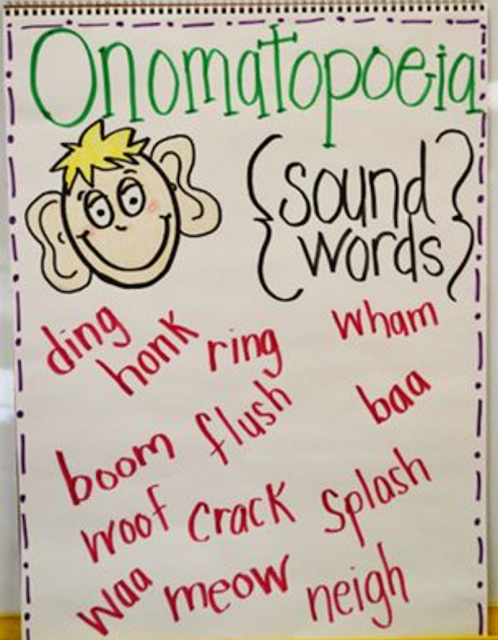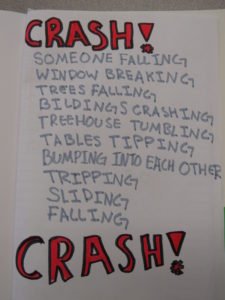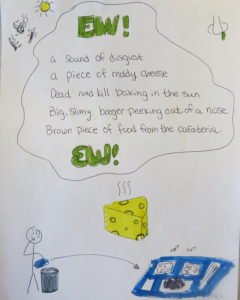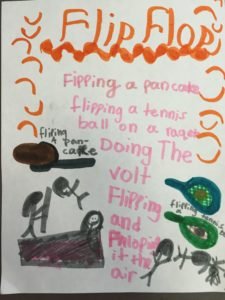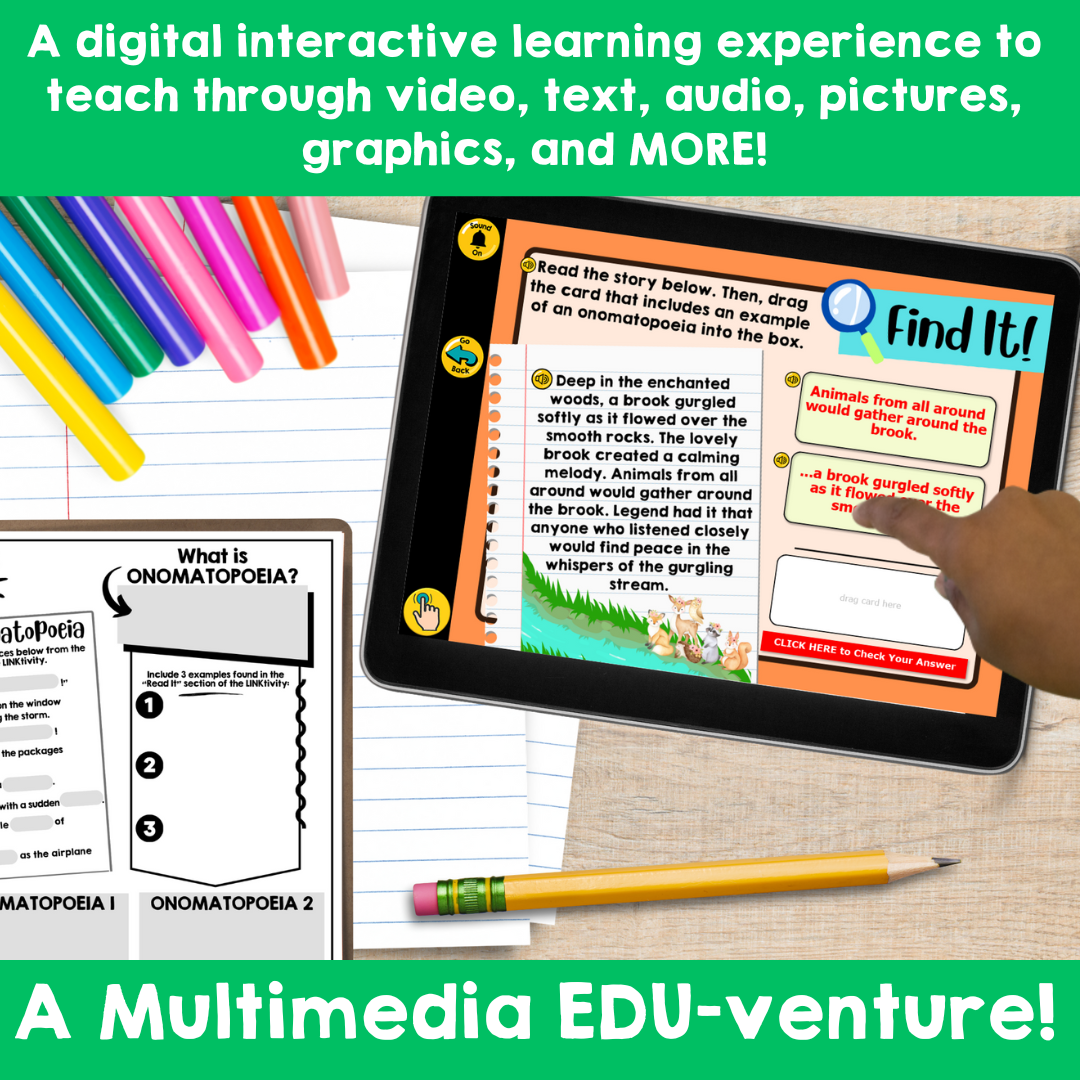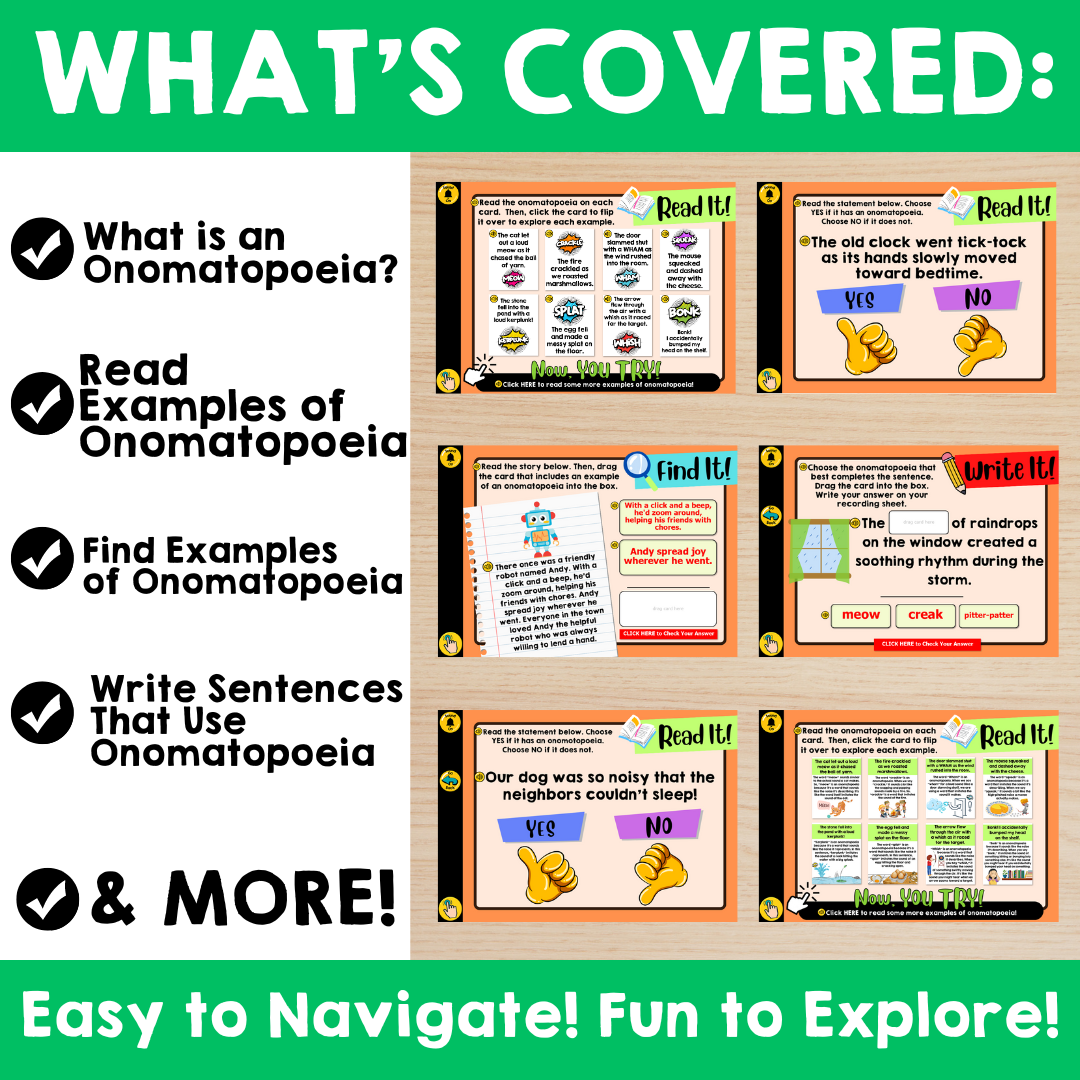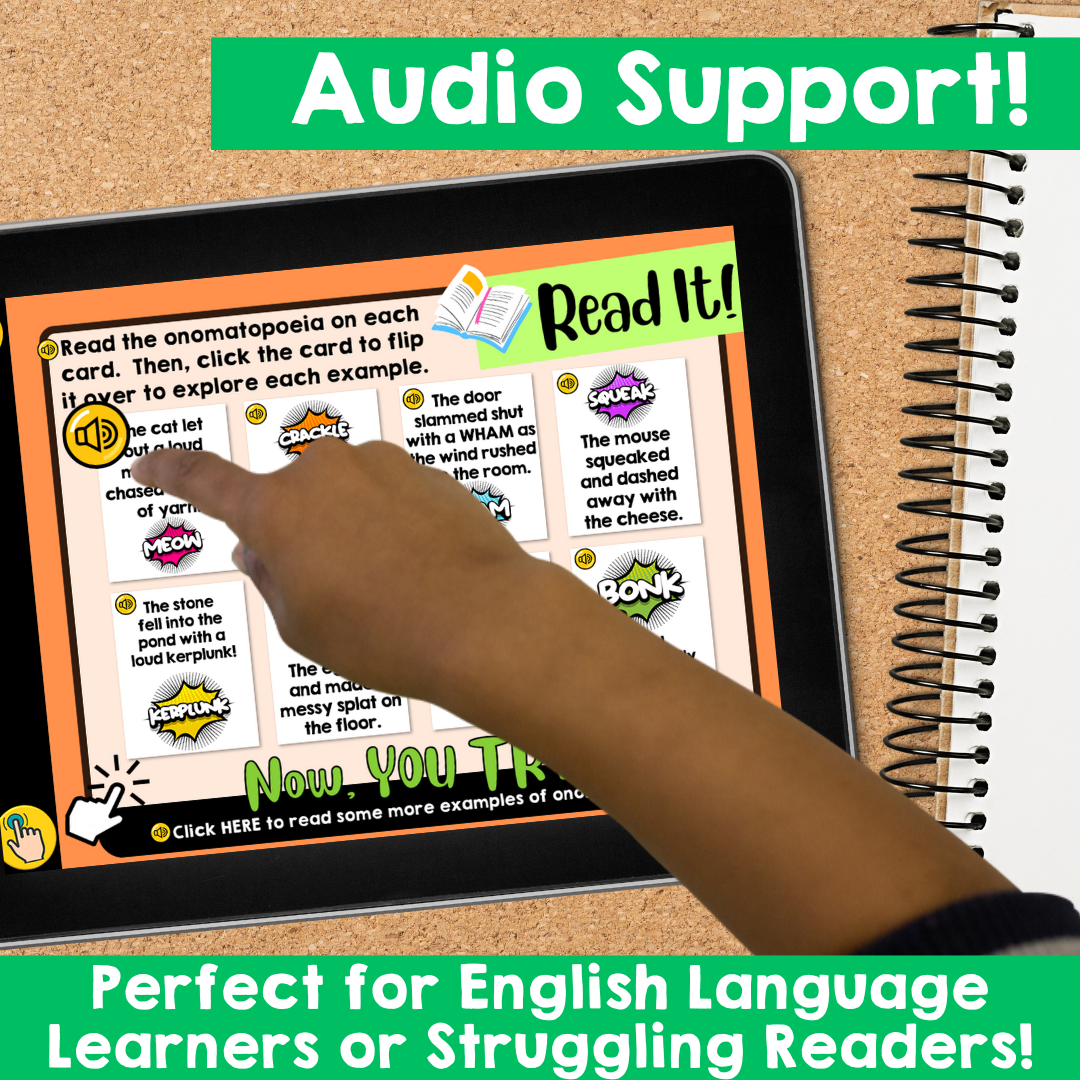Engage, Learn, and Create: Exciting Onomatopoeia Activities for Kids
Welcome to the world of onomatopoeia, where language and sound intersect to spark imagination and expression. As elementary educators specializing in grades 3, 4, or 5, you have an exciting opportunity to introduce your students to this intriguing linguistic concept and witness their creativity flourish.
Onomatopoeia manifests in various forms, each adding a distinct touch to our language. From words that mimic real sounds to those that create a sense of action, onomatopoeia breathes life into narratives and captivates young minds in ways conventional vocabulary often cannot.
Prepare for an exploration filled with laughter, curiosity, and limitless imagination as we dive into engaging onomatopoeia activities crafted to cultivate a passion for language in your classroom. Strap in and embark on a journey into the realm of onomatopoeic marvels!
If you’ve been following along, you’ll note that this post is part of a 6-part series all about how to teach figurative language to your students. We’re tackling each figure of speech one by one so that you can walk away with tips and tools for your third, fourth, or fifth graders!
Other Posts in This Series:
From A to Z: Alliteration Made Easy (Step-by-Step Teaching Strategies)
Hyperbole Lessons & Activities That Will Make Your Class Roar with Laughter
Exploring Figurative Language: Fun Strategies to Teach Personification to Elementary Students
Idioms (Coming Soon!)
Understanding Onomatopoeia
Let's start by unraveling onomatopoeia in a way that's engaging and easy for elementary students to grasp.
Onomatopoeia is like a magic trick in language where words sound like the noises they describe. For example, "buzz" sounds like a buzzing bee, and "splash" sounds like water splashing. But - did you know that there are actually 4 types of onomatopoeia? Let’s look a bit closer at each one:
The Four Types of Onomatopoeia:
Real Words that Sound Like Real Things: These are words that directly mimic sounds, like "meow" for a cat's sound. They make language more lively and are the most common type of onomatopoeia.
Real Words Made to Evoke Sounds: Sometimes, words are used to make us think of a sound, even if they don't sound like it themselves. For instance, repeating "bell" in a poem can make us hear the ringing of bells.
Made-up Words that Sound Real: When there's no perfect word for a sound, writers create new ones. James Joyce invented "tattarrattat" to mimic a door knock in his book.
Letters Mimicking Sounds: Sometimes, letters alone can create sounds, like "Zzzzzz" for sleeping or "achoo" for a sneeze.
Understanding the specific categories of onomatopoeia and being able to categorize different examples may not be crucial for your students to memorize. However, as a teacher, it is beneficial for you to grasp these categories. This understanding can guide your discussions with students and enable you to explain why certain words or letters create onomatopoeia.
By using onomatopoeia, writers and storytellers make their words come alive. It's like adding colorful paint to a picture, making stories more vivid and exciting. As we dive deeper into onomatopoeia, we'll discover how it can turn ordinary writing into something extraordinary!
Benefits of Teaching Onomatopoeia
Teaching onomatopoeia goes beyond just learning a fun linguistic concept; it brings a host of educational benefits that can greatly impact students' language skills and creativity. Let's delve into some of these benefits:
Improved Language Skills and Creativity: By exploring onomatopoeia, students expand their vocabulary and learn to express sounds and actions more vividly in writing and speech. This enhances their language skills and encourages them to think creatively when describing scenes and events.
Engagement of the Senses: Onomatopoeia encourages students to engage their senses when writing and communicating. Instead of simply stating that something made a sound, they learn to use descriptive words that evoke specific auditory experiences, making their writing more immersive and engaging.
Enhanced Reading Comprehension and Engagement: When students encounter onomatopoeic words in texts, it adds an interactive element to their reading experience. They not only understand the sound being described but also connect more deeply with the content, leading to improved comprehension and retention of information.
By incorporating onomatopoeia into your lessons, you create a dynamic learning environment that fosters language development, creativity, and active engagement with texts. It's a valuable tool that empowers students to become more expressive and effective communicators.
FREE POSTERS
Snag this FREE set of 7 posters to display in your classroom as you teach about types of figurative language.
Mini-lessons & Activities to Introduce Onomatopoeia:
Whole-Class Mini-Lesson
A straightforward way to prepare your students for learning about onomatopoeia is through a whole-class visual activity. Provide students with several picture cards (see examples). For each picture card, instruct students to pair up and discuss with a peer what sounds they imagine are linked to each picture.
For instance, when observing the water picture, students might think of sounds like "splash," "plop," or "drip." Similarly, when viewing the bee picture, they might envision sounds such as "buzz," and so on.
Create an anchor chart
To make the concept of onomatopoeia more tangible and engaging for elementary students, using an anchor chart can be incredibly effective.
For introducing onomatopoeia, you can create an anchor chart with a simple definition of onomatopoeia at the center, surrounded by examples and illustrations that showcase how words mimic sounds in literature and everyday language. This visual representation helps students grasp the concept and encourages active participation in discussions.
You can even use the same picture cards that you used in the introduction activity above one your anchor chart, accompanied by an onomatopoeia label for each picture.
These teacher-created anchor charts can serve as inspiration for creating your own.
MENTOR TEXTS, POETRY, AND SONG LYRICS THAT USE Onomatopoeia
Studying mentor texts, poetry, and song lyrics that utilize onomatopoeia offers students tangible examples of how this literary technique is employed by writers and artists. These real-life instances showcase how onomatopoeia enhances writing by painting vivid images and eliciting emotions.
Here are different ways to effectively use these texts and gradually shift responsibility to your students:
Start with Read-Alouds and Collaborative Analysis: Begin by using mentor texts with onomatopoeia examples as read-alouds during your reading lessons. Engage the class in identifying onomatopoeic words within these texts. Create a class chart to highlight and discuss these examples, enhancing comprehension and involvement.
Move to Small Group Investigation: Provide small groups with mentor texts, poetry, or song lyrics containing onomatopoeia instances. Encourage students to work together to identify and analyze onomatopoeia in the given texts. This activity fosters teamwork, critical thinking, and a deeper understanding of onomatopoeia's use in literature.
Apply Learning through Independent Reading: Offer a selection of texts with onomatopoeia examples for students to explore during independent reading sessions. Encourage them to document the onomatopoeic words they discover using a graphic organizer or reading journal. This promotes independent exploration and reinforces the recognition and application of onomatopoeia in different contexts.
Here are a few texts to get you started on your exploration. Look for them in your school or local libraries, or click on the links below to find them on Amazon.com (affilate links)
MEntor Texts
Mr. Brown Can Moo Can You by Dr. Seuss
Muncha! Muncha! Muncha! by Candace Fleming
When Papa Snores by Melinda Long
Slop Goes the Soup: A Noisy Warthog Word Book by Pamela Duncan Edwards
City Lullaby by Marilyn Singer
Everybody in the Red Brick Building by by Anne Wynter
Ten Ways to Hear Snow by Cathy Camper
Listen by Gaby Snyder
Have You Heard the Nesting Bird? by Rita Gray
Cat Says Meow and other an*i*mal*o*poe*ia by Michael Arndt
Poetry
"Rain" by Shel Silverstein
"Spring Peepers" by Aileen Fisher
"Popcorn" by James Stevenson
"The Thunderstorm" by Margaret Wise Brown
"Fireworks" by Jack Prelutsky
"The River" by Langston Hughes
"The Wind" by Christina Rossetti
"The Snoring Cat" by Kenn Nesbitt
Songs
🎵Boom Boom Pow by The Black Eyed Peas
The repeated use of "boom" in the chorus.
🎵Bang Bang by Jessie J, Ariana Grande, and Nicki Minaj
The word "bang" is used throughout the song.
🎵Tick Tock by Kesha
Tick tock on the clock, but the party don't stop, no
🎵Zip-A-Dee-Doo-Dah from the movie: Song of the South
Zip-a-dee-doo-dah, zip-a-dee-ay, my, oh, my, what a wonderful day
🎵Bibbidi-Bobbidi-Boo from the movie: Cinderella
Salagadoola, mechicka boola, bibbidi-bobbidi-boo
Exciting Activities to Practice Using Onomatopoeia
Engaging students in learning about onomatopoeia can be a fun and interactive experience that sparks their imagination and creativity. Through a variety of exciting activities, students not only explore the fascinating world of words that mimic sounds but also develop their language skills and expressiveness.
From collaborative games to creative writing exercises and multimedia projects, these onomatopoeia activities offer educators diverse options to make learning enjoyable and meaningful for students of all ages. Let's dive into these exciting onomatopoeia activities that will have your students eagerly exploring the sounds of language!
Onomatopoeias A-Z
This is a great exercise that will get students thinking about a variety of onomatopoeia words.
Begin by having students collectively create an A-Z list of onomatopoeias as a class or in small groups. Each letter should have an onomatopoeic word associated with it, fostering creativity and vocabulary exploration.
Then, this list will later serve as a resource for students to use to enhance their writing. Consider creating a master list or putting together a printable copy that students can store in a writing folder or notebook.
Missing a letter? Check out this list of onomatopoeia to fill in the gaps or use an AI tool like ChatGPT and ask it to populate a list of onomatopoeias for each letter of the alphabet.
Guess the Onomatopoeia (Warm-Up Activity)
This warm-up is a great whole-class activity that serves as a review of onomatopoeia.
Start by listing three things that produce an onomatopoeic sound (e.g., "DRIP") or three situations that elicit an onomatopoeic response (e.g., "OUCH!"). For instance, a student might say, "a faucet, a gutter, a car after a wash" to represent "DRIP," or "a paper cut, a flu shot, a splinter in your hand" to represent "OUCH!"
Next, select a student to read out the phrases and have other students guess the onomatopoeia. The guessing student takes the next turn if they guess correctly. Continue until everyone has participated or the allotted time ends.
Writing with Onomatopoeia
Writing Activity 1: Start Simple!
This is a simple writing activity from Fun Writing Ideas that is perfect for students just getting started in writing with onomatopoeia. Plus, it’s the perfect follow-up activity to the warm-up activity mentioned above.
Students select an onomatopoeic word and create a list of nouns and phrases that produce that sound. For example, using "SPLASH," they might list things like birds in a bird bath, babies in a tub, or the end of a waterslide. Finally, they write the onomatopoeic word again below their list.
Check out these student examples from Fun Writing Ideas:
Writing Activity 2: Create a Comic Strip
Utilize tools like Canva (that have tons of templates) to have students create comic strips incorporating onomatopoeic words to depict actions and sounds effectively. Plus Canva offers other graphics that students can incorporate into their comic strip design.
Of course, students can also complete this activity on paper as well.
Writing Activity 3: Write An Animal Poem
Students can write any poem using onomatopoeia, however, providing an animal prompt such as a pony, puppy, or lion, gives students a starting point with onomatopoeia sounds they are likely already familiar with.
Challenge students to write a poem using onomatopoeia to describe the animal's actions or sounds. Students can either choose their own animal or be assigned one.
Onomatopoeia Race
Divide a SMARTboard or whiteboard into two sections and group students into pairs. Two pairs at a time come to the board. Call out an onomatopoeic word, and the partners race to list three things that make that sound. Adjust the number of items listed based on the students' age and skill level.
Onomatopoeia Pop Art
Have you ever heard of the artist, Roy Lichtenstein? Roy Lichtenstein was an American pop artist in the 1960s known for his bold and vibrant comic strip-inspired artworks. He often used onomatopoeia words in bright, bold colors throughout his work.
One fun activity would be for students to create Roy Lichtenstein-inspired art using onomatopoeias. Check out this great video that gives students a little background about Lichtenstein and walks them through the art project:
Combine these art projects with the comic strip activity mentioned earlier and you’ll have an amazing bulletin board display in your classroom or hallway! Simply place the onomatopoeia word above each student’s comic strip!
Here are some other video tutorials that you and your students might enjoy:
Roy Lichtenstein inspired Onomatopoeia Art
Let's make POP art like Roy Lichtenstein!
Roy Lichtenstein Onomatopoeia Collage
Onomatopoeia LINKtivity®
Teachers have been raving about our LINKtivity series focused on figurative language. And our LINKtivity on onomatopoeia has been a great addition to many literacy centers!
In our Onomatopoeia LINKtivity, students dive into a lively learning adventure where they can experience, listen to, and practice using onomatopoeia in different ways.
It begins with an engaging video that introduces and delves into the concept of onomatopoeia. You can use our onomatopoeia video to captivate students visually and audibly.
After watching the video, students participate in guided practice as they read, identify, and writing with onomatopoeia all within the LINKtivity platform.
This multimedia, interactive approach enhances their understanding and application of onomatopoeia in a digital learning environment.
Ready to get started with teaching onomatopoeia and other types of figurative language? Be sure to check out our entire series of Figurative Language LINKtivities!
The Power of Words
Discover the Power of Creative Expression: By engaging with onomatopoeia, students unleash their creativity and learn to express ideas and emotions in unique and exciting ways.
Enhance Language Skills: Exploring onomatopoeic words improves vocabulary, encourages descriptive language use, and fosters a deeper understanding of sound symbolism in writing.
Promote Active Learning: Onomatopoeia activities encourage active participation, critical thinking, and collaborative problem-solving, making learning an interactive and engaging experience for students.
Boost Confidence and Engagement: As students master the use of onomatopoeia, they gain confidence in their language abilities and become more engaged in literary exploration, leading to increased enthusiasm for reading and writing.
Ignite Imaginations: Onomatopoeia sparks imagination and allows students to visualize and experience sounds, bringing stories and poems to life in vivid and memorable ways.
Experience Fun and Joy in Learning: Above all, onomatopoeia activities inject a sense of fun and joy into the learning process, creating an enjoyable and enriching educational journey for students of all ages.






